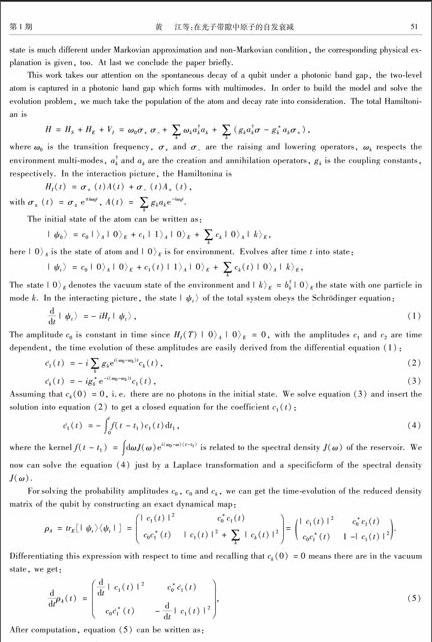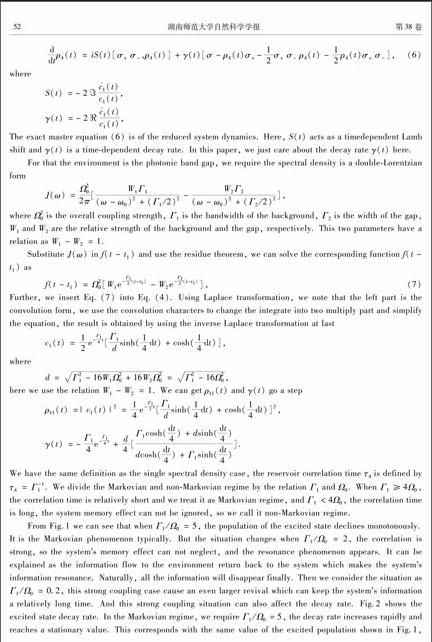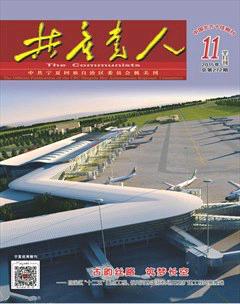在光子带隙中原子的自发衰减
黄江 谢钦 邱彩虹



摘要 研究了一个二能级原子在具有双洛伦兹谱密度的光子带隙中激发态布居的自发衰减动力学行为.通过对比自发衰减动力学行为在马尔科夫近似条件下和非马尔科夫条件下的演化特性,发现了在这两种条件下演化动力学有着明显区别.非马尔科夫记忆效应使得流入环境中的部分信息回复至系统中来,从而导致了原子布居的震荡.另外,研究结果表明耦合强度与衰减率有着密切联系.
关键词 光子带隙;双洛伦兹谱;非马尔科夫
Quantum communication and information has attracted much attention of many physicists working in the area of quantum mechanics for a few decades[16]. Due to the development of experiments, the corresponding theoretical studies are also developed rapidly. As we know that every realistic quantum systems would interact with its environment, which causes the dissipation and decoherence[712]. Dissipation and decoherence in open quantum systems can be described by the standard techniques of the theory of quantum Markovian process with Lindbald structure quantum master equation. One believe that the Markovian process happens when the systemreservoir coupling is weak. However, with the rapid development of experimental technology, the strong coupling is considered in some works. The process with strong coupling is called as nonMarkovian process. Recently, the nonMarkovian dynamics of the open quantum system were investigated within exact master equation[1320]. In this paper, we consider an atom spontaneous decay regulation in the photonic band gap. We find that the population regulation of the excited state is much different under Markovian approximation and nonMarkovian condition, the corresponding physical explanation is given, too. At last we conclude the paper briefly.
This work takes our attention on the spontaneous decay of a qubit under a photonic band gap, the twolevel atom is captured in a photonic band gap which forms with multimodes. In order to build the model and solve the evolution problem, we much take the population of the atom and decay rate into consideration. The total Hamiltonian is
H=HS+HE+VI=ω0σ+σ-+∑kωkakak+∑k(gkakσ-g*kakσ+),
where ω0 is the transition frequency, σ+ and σ- are the raising and lowering operators, ωk respects the environment multimodes, ak and ak are the creation and annihilation operators, gk is the coupling constants, respectively. In the interaction picture, the Hamiltonina is
湖南师范大学自然科学学报第38卷
第1期
黄江等:在光子带隙中原子的自发衰减
HI(t)=σ+(t)A(t)+σ-(t)A+(t),
with σ±(t)=σ±e±iω0t, A(t)=∑kgkake-iωkt.
The initial state of the atom can be written as:
|ψ0〉=c0|〉A|0〉E+c1|1〉A|0〉E+∑kck|0〉A|k〉E,
here |0〉A is the state of atom and |0〉E is for environment. Evolves after time t into state:
|ψt〉=c0|0〉A|0〉E+c1(t)|1〉A|0〉E+∑kck(t)|0〉A|k〉E,
The state |0〉E denotes the vacuum state of the environment and |k〉E=bk|0〉E the state with one particle in mode k. In the interacting picture, the state |ψt〉 of the total system obeys the Schrdinger equation:
ddt|ψt〉=-iHI|ψt〉,(1)
The amplitude c0 is constant in time since HI(T)|0〉A|0〉E=0, with the amplitudes c1 and c2 are time dependent, the time evolution of these amplitudes are easily derived from the differential equation (1):
1(t)=-i∑kgkei(ω0-ωk)tck(t),(2)
k(t)=-ig*ke-i(ω0-ωk)tc1(t),(3)
Assuming that ck(0)=0, i.e. there are no photons in the initial state. We solve equation (3) and insert the solution into equation (2) to get a closed equation for the coefficient c1(t):
1(t)=-∫t0f(t-t1)c1(t)dt1,(4)
where the kernel f(t-t1)=∫dωJ(ω)ei(ω0-ω)(t-t1) is related to the spectral density J(ω) of the reservoir. We now can solve the equation (4) just by a Laplace transformation and a specific
form of the spectral density J(ω).
For solving the probability amplitudes c0, c0 and ck, we can get the timeevolution of the reduced density matrix of the qubit by constructing an exact dynamical map:
ρA=trE[|ψt〉〈ψt|]=|c1(t)|2c*0c1(t)
c0c*1(t)|c1(t)|2+∑k|ck(t)|2=
|c1(t)|2c*0c1(t)
c0c*1(t)1-|c1(t)|2.
Differentiating this expression with respect to time and recalling that ck(0)=0 means there are in the vacuum state, we get:
ddtρA(t)=ddt|c1(t)|2c*01(t)
c0*1(t)-ddt|c1(t)|2,(5)
After computation, equation (5) can be written as:
ddtρA(t)=iS(t)[σ+σ-,ρA(t)]+γ(t)[σ-ρA(t)σ+-12σ+σ-ρA(t)-12ρA(t)σ+σ-],(6)
where
S(t)=-2 1(t)c1(t),
γ(t)=-2 1(t)c1(t),
The exact master equation (6) is of the reduced system dynamics. Here, S(t) acts as a timedependent Lamb shift and γ(t) is a timedependent decay rate. In this paper, we just care about the decay rate γ(t) here.
For that the environment is the photonic band gap, we require the spectral density is a doubleLorentzian form
J(ω)=Ω202π[W1Γ1(ω-ω0)2+(Γ1/2)2-W2Γ2(ω-ω0)2+(Γ2/2)2],
where Ω20 is the overall coupling strength, Γ1 is the bandwidth of the background, Γ2 is the width of the gap, W1 and W2 are the relative strength of the background and the gap, respectively. This two parameters have a relation as W1-W2=1.
Substitute J(ω) in f(t- t1) and use the residue theorem, we can solve the corresponding function f(t- t1) as

